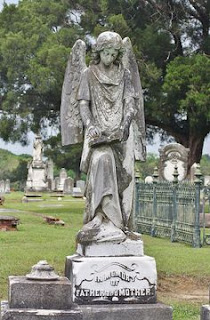For five days in 1870 rain fell continuously on the graves of the Lemoine family
One of the strangest meteorological mysteries in history took place in Mobile, Alabama, in 1870 at the Catholic Cemetery above Three-Mile Creek. Several witnesses, including the cemetery groundskeeper, claim that a gentle but steady rain fell continuously for five days over the cemetery.
Stranger still, the downpour was confined to just one particular area of the graveyard-- the Lemoine family plot.
It was October 29 when the rain began to fall, according to cemetery groundskeeper John Rosset. Rosset, who first noticed the strange phenomenon, brought it to the attention Louis B. Lemoine, whose father, Victor, had been laid to rest in the family plot in 1851.
On the evening of November 2, Louis drove out to the cemetery to witness the strange storm with his own eyes. He gave the following account to the Mobile Register:
"I drove out there last evening to satisfy myself, and, to my intense astonishment, I saw that a column of rain was coming down without ceasing, which although hardly powerful enough to lay the dust was enough to wet the hands or any article, and at times rained quite hard.
"The volume of rain fell inside of the enclosure and nowhere else, as the weather was and has been bright and clear all the time during the five days the rain has been falling on these graves. There are thirteen of my family buried in the lot upon which it has been raining.
"My mother, brother, and sister visited the spot yesterday and the day before to satisfy themselves about this matter, and declare that they too saw this wonderful phenomenon."
During the course of this mysterious storm, over 200 residents of Mobile traveled to the cemetery to witness the event, many of whom were convinced that some sort of divine hand was responsible. Others of a less superstitious bent insisted that there had to be a perfectly logical scientific explanation for the phenomenon-- though nobody has ever been able to figure out what that explanation might be.

|
| The Old Catholic Cemetery in Mobile |
One of the strangest meteorological mysteries in history took place in Mobile, Alabama, in 1870 at the Catholic Cemetery above Three-Mile Creek. Several witnesses, including the cemetery groundskeeper, claim that a gentle but steady rain fell continuously for five days over the cemetery.
Stranger still, the downpour was confined to just one particular area of the graveyard-- the Lemoine family plot.
It was October 29 when the rain began to fall, according to cemetery groundskeeper John Rosset. Rosset, who first noticed the strange phenomenon, brought it to the attention Louis B. Lemoine, whose father, Victor, had been laid to rest in the family plot in 1851.

|
| One of many historic graves at the cemetery |
On the evening of November 2, Louis drove out to the cemetery to witness the strange storm with his own eyes. He gave the following account to the Mobile Register:
"I drove out there last evening to satisfy myself, and, to my intense astonishment, I saw that a column of rain was coming down without ceasing, which although hardly powerful enough to lay the dust was enough to wet the hands or any article, and at times rained quite hard.
"The volume of rain fell inside of the enclosure and nowhere else, as the weather was and has been bright and clear all the time during the five days the rain has been falling on these graves. There are thirteen of my family buried in the lot upon which it has been raining.
"My mother, brother, and sister visited the spot yesterday and the day before to satisfy themselves about this matter, and declare that they too saw this wonderful phenomenon."
|
|
| A family plot at the Catholic Cemetery in Mobile |
During the course of this mysterious storm, over 200 residents of Mobile traveled to the cemetery to witness the event, many of whom were convinced that some sort of divine hand was responsible. Others of a less superstitious bent insisted that there had to be a perfectly logical scientific explanation for the phenomenon-- though nobody has ever been able to figure out what that explanation might be.
